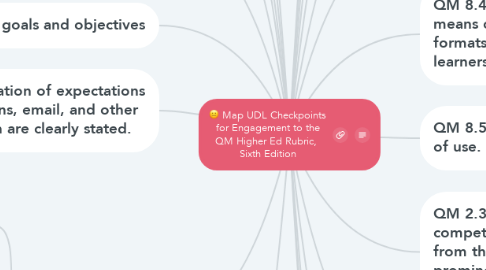
1. In a writing course, students focus on learning a medium and attribution, but their content is specific to their research interests
2. QM 4.4 The instructional materials represent up-to-date theory and practice in the discipline.
2.1. QM 1.5 Minimum technology requirements for the course are clearly stated, and information on how to obtain the technologies is provided.
3. QM 1.4 Course and institutional policies with which the learner is expected to comply are clearly stated within the course, or a link to current policies is provided.
4. :slightly_frowning_face: QM 5.3 The instructor’s plan for interacting with learners during the course is clearly stated.
4.1. :bulb: Administer a Quiz that specifies questions promoting self-assessment.
5. QM 2.2 The module/unit-level learning objectives or competencies describe outcomes that are measurable and consistent with the course-level objectives or competencies.
5.1. UDL 8.1 Heighten salience of goals and objectives
5.1.1. COURSE DESIGN IDEA: Incorporate learning objectives in assignment rubrics
5.1.1.1. Add objectives to assignment instructions.
5.1.1.2. Use the assignment rubrics with the learning objectives for student self-assessment
6. QM 1.2 Learners are introduced to the purpose and structure of the course.
6.1. 7.2 Optimize Relevance, value, and authenticity
6.1.1. Course design idea: include learning objectives and practical outcomes with explanation of assignments
7. QM 4.1 The instructional materials contribute to the achievement of the stated learning objectives or competencies.
8. UDL 8.1 Heighten salience of goals and objectives
9. QM 1.3 Communication of expectations for online discussions, email, and other forms of interaction are clearly stated.
10. QM 1. Course Overview and Introduction
10.1. QM 1.6 Computer skills and digital information literacy skills expected of the learner are clearly stated.
10.2. QM 1.8 The self-introduction by the instructor is professional and is available online.
10.2.1. UDL 8.3 Foster collaboration and community
10.3. QM 1.7 Expectations for prerequisite knowledge in the discipline and/or any required competencies are clearly stated.
10.3.1. UDL 8.1 Heighten salience of goals and objectives
10.4. Promote expectations and beliefs that optimize motivation
10.4.1. LMS based peer review guided by course needs allows students to interact with the writing projet.
10.5. QM 1.9 Learners are asked to introduce themselves to the class.
10.5.1. UDL 8.3 Foster collaboration and community
10.5.1.1. Use discussion areas for communal learning about the major text material, kind of like collaborative notes, but housed in the LMS, rather than an outside software.
11. QM 4. Instructional Materials
11.1. QM 4.2 The relationship between the use of instructional materials in the course and completing learning activities is clearly explained.
11.2. QM 4.3 The course models the academic integrity expected of learners by providing both source references and permissions for use of instructional materials.
11.3. QM 4.5 A variety of instructional materials is used in the course.
11.3.1. UDL 7.1 Optimize Individual Choice and Autonomy
11.3.2. UDL 7.1 Optimize Individual Choice and Autonomy
11.3.3. QM 8.3 The course provides accessible text and images in files, documents, LMS pages, and web pages to meet the needs of diverse learners.
11.3.3.1. UDL 7.1 Optimize Individual Choice and Autonomy
11.3.4. UDL 8.2 Vary demands and resources to optimize challenge
12. QM 7.1 UDL 7.1 Optimize Individual Choice and Autonomy
12.1. Course design idea (From KD): Allow student to have options that are relevant to their learning experiences and environment ie. with rationale
13. QM 7.3 Course instructions articulate or link to the institution’s academic support services and resources that can help learners succeed in the course.
13.1. QM 8.2 The course design facilitates readability.
14. UDL 7.2 Optimize Relevance, Value and Authenticity
15. QM 8.3 The course provides accessible text and images in files, documents, LMS pages, and web pages to meet the needs of diverse learners.
16. QM 7.4 Course instructions articulate or link to the institution’s student services and resources that can help learners succeed.
17. UDL 8.3 Foster collaboration and community
18. QM 8.4 The course provides alternative means of access to multimedia content in formats that meet the needs of diverse learners.
19. QM 8.5 Course multimedia facilitate ease of use.
20. QM 2.3 Learning objectives or competencies are stated clearly, are written from the learner’s perspective, and are prominently located in the course.
20.1. 6.4 The course provides learners with information on protecting their data and privacy.
20.2. QM 2.4 The relationship between learning objectives or competencies and learning activities is clearly stated.
20.2.1. UDL 7.2 Optimize Relevance, Value and Authenticity
21. QM 1.1 Instructions make clear how to get started and where to find various course components.
21.1. UDL 7.3 Minimize Threats and Distraction
21.1.1. Create formative assessments that have students review major assignment projects through guided notes to check their understanding about what they need to do. Include a question that asks them what questions/clarifications they have about the project.
22. 5. Learner Activities and Learner Interaction
22.1. QM 5.2 Learning activities provide opportunities for interaction that support active learning.
22.1.1. UDL 8.3 Foster collaboration and community
22.2. QM 5.1 The learning activities promote the achievement of the stated learning objectives or competencies.
22.2.1. For example, objectives are reviewed at the beginning of the module and referred to during learning activities
22.3. QM 5.4 The requirements for learner interaction are clearly stated.
23. 6. Course Technology
23.1. QM 6.1 The tools used in the course support the learning objectives or competencies.
23.2. QM 6.2 Course tools promote learner engagement and active learning.
23.2.1. UDL 8.3 Foster collaboration and community
23.2.1.1. Social annotation tool (eg: hypothesis) to read and take notes together
23.2.2. UDL 8.3 Foster collaboration and communit
23.2.2.1. Web 2.0 Tools: Flipgrid, Nearpod, Pear Deck, Padlet, Diigo, Mindmeister, Poll Everywhere, Jamboard, Google apps, Microsoft TEAMS, Apple tools, etc.
23.3. QM 6.3 A variety of technology is used in the course.
23.3.1. UDL 7.1 Optimize Individual Choice and Autonomy
